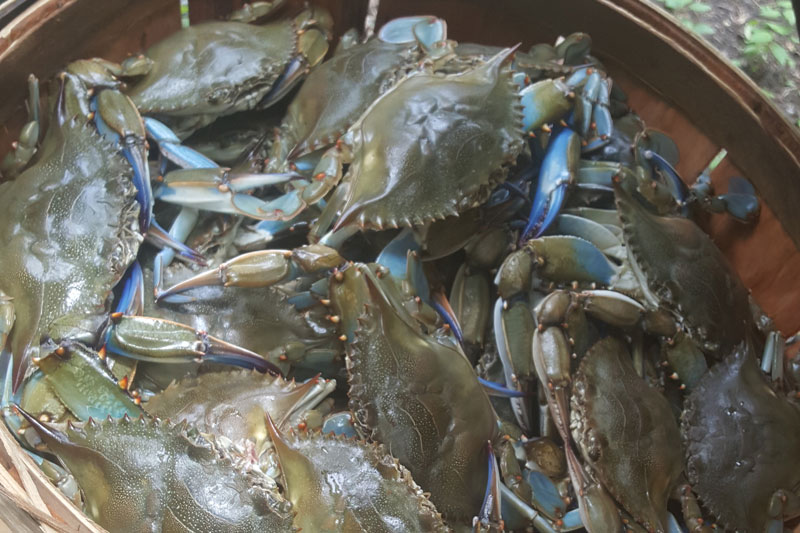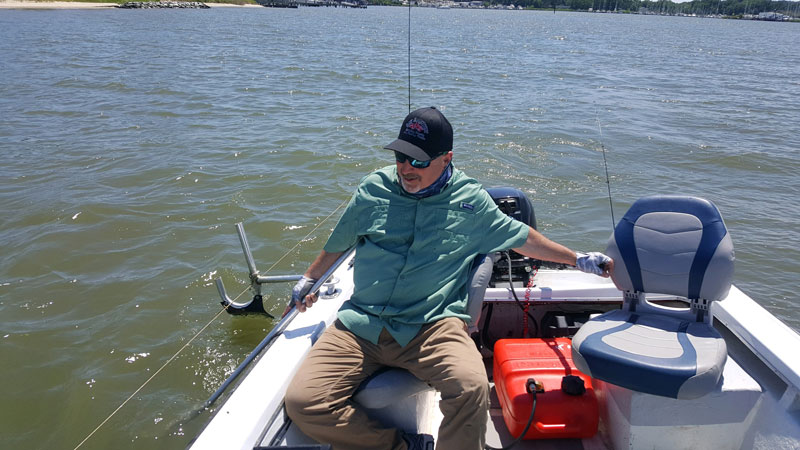Facts are facts: put a recreational crabber up against a commercial crabber, and the commercial waterman is going to win 10 out of 10 times. Those folks are out on the water every day, they know the tricks of the trade, and someone who crabs a couple-few times a month can’t really be expected to compete. Now, set aside who catches more crabs and let’s note that running a trot-line for crabs isn’t as easy as it seems. Baiting up 200-plus snoods is no piece of cake, tangling the line during deployment – or worse yet in your prop – is always a possibility, and choosing the right depth and spot can be a serious challenge. What’s worse is that if you do any of these things wrong, you may end up with a whole lot of work and no crabs. On the other hand, when everything goes right there’s usually no more efficient way for a recreational crabber to fill a bushel basket. So we talked with Dan Mallonee, of Bay Country Crabbing Supply, to find out some of the tips and tricks the pros use.

1. Look for hard bottom. “There are a lot of contributing factors to running a trot line,” Dan says. “But start with crabbing in an area where there’s a natural food source because if you’re crabbing where there are no crabs you won’t catch much regardless of all the other factors.”
How do you find good bottom in the first place? In order to continually discover new hotspots, Mallonee says that many sharpies have a 300- to 600-foot “sacrificial” line which they use to prospect, while placing the main line in an area they have already have more confidence in. Recreational crabbers are limited in line length while commercials are not, however, this doesn’t mean you can’t play the same game albeit on a smaller scale. Simply carry some snap-traps, in addition to your trot line. You can set them out in different areas away from your trot-line, to prospect.
2. Stop making them drop. Crabs that drop off before they can be netted are often alerted for one reason or another, and it’s usually our own fault. The reasons can include:
- Excessive movement
- Excessive speed
- Rapid water temperature changes
- Shadows causing rapid light changes
Carelessly swinging a net over the surface of the water can be enough to scare a crab off a bait, much less the rapid movements caused by a boat bouncing in rough seas. Excessive speed can also cause them to drop, and interestingly, is connected to the issue of rapid temperature changes – because pulling a crab quickly up through a strong thermocline can alert them. The lesson here is that when you see a potent thermocline on your fishfinder, try creeping along slower than usual. Then, there are shadows to worry about. You’ve probably heard that a boat’s shadow can cause crabs to drop, and Dan confirms the theory. He also notes that when crabs have moved deep and are under a strong thermocline and constantly drop off, it may be most effective to temporarily switch over to traps entirely since your quarry doesn’t have the option of dropping the bait once you start pulling up the trap. (If you never see a crab but your baits are coming up chewed, that’s a tip-off that crabs are dropping off while still down deep).
3. Play the tide. Just as with fishing, playing the tide can have a huge impact on the catch. Also like fishing, crabs often bite best on the change of a tide. When the switch is happening it’s time to stop taking breaks, work fast, and keep running that line – wait until the tide’s quit, to take a rest.
4. Consider “micro-crabbing.” Sometimes the crabs just aren’t moving (like that dead tide timeframe), and when you lay out your line, you’ll catch all the crabs in that one area in a couple of runs. If you have a good first run and then the catch drops off quickly, it’s a sign you should move the line. It doesn’t have to be moved far, but just needs to be laid over new ground where you haven’t already scooped up the crabs in the immediate area. Dan suggests pulling the line and re-laying it, as opposed to dragging it onto new turf. “Dragging puts a lot of wear on your gear and can lead to snags,” he says. “It’s usually better to just pull the line up and then lay it out again.”
5. Get the bait right. There are actually a lot more nuances to baiting up a trot line than some people think. For starters, fowl necks are a lot tougher than regular chicken necks. Second, as you’re baiting up, strip any remaining skin off the neck and throw it away. The skin may be oily but for whatever reason it doesn’t attract the crabs and a neck covered in skin is no good. And third, you’ll do best if you use clam early and late in the season. “You’ll know when it’s time to switch by watching the commercial guys,” he says. “And remember to show them proper etiquette. Slow down when passing or approaching them, be friendly, and if you’re not sure where their floats are be sure to ask.”

BONUS TIPS FOR TROT-LINING FOR CRABS
- PVC “sticks” will get you by for a while, but they break with no warning. Serious crabbers will get an aluminum stick.
- Get a good net with a galvanized mesh. Everyone has their own favorite version, but don’t skimp. And if it’s too long for your boat and rig, don’t be afraid to cut the handle down.
- If necks get snagged on the hoop of your net, you can add a strip of tight-mesh wire around the top six to seven inches and secure it in place with zip-ties.
For more crabbing intel, check out How to Go Crabbing With Pull Traps, and Crabbing 101: Trot-Lining Tips.
Want to learn how to trot line from a kayak? Check out this video: